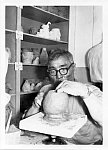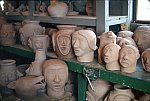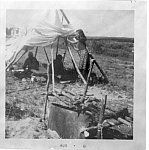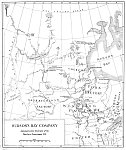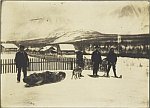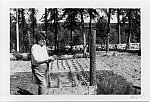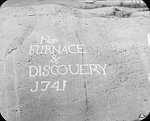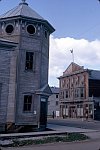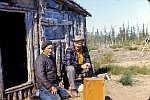Life in a Northern Town
Author: Jennifer Jozic Page 1 | Page 2 | Page 3
Families will often “make camp” while hunting. In this way children learn wilderness survival skills from their friends and family. Sometimes people on the tundra create “Arctic Survival Schools” to teach local people and outsiders these same skills. They may also use the opportunity to pass on knowledge of the more traditional methods.
Inuit culture is renowned for its beautiful art. Many Inuit artists belong to cooperatives that store and market their work to a much wider audience in the south. These pictures show an artist creating a sculpture and a storage room full of pieces.
There are five Dene Nations within the Northwest Territories: the Gwich’in, Sahtu Dene, Tåîchô, Dÿne Súåine and South Slavey. They refer to the land that they have traditionally lived on as Denedeh. The Dene and Cree peoples have hunted in the boreal forests of Canada since time immemorial, and are closely associated with the moose, bears, caribou, and fish. Dene and Cree also make up a significant part of the population in the Yukon and northern parts of the provinces.
Father Picard of Black Lake recalls that “[i]n the days prior to the Second World War, the Indians had a very simple life. They depended on fishing hunting and trapping. They lived in the bush for almost all of the year and there were no permanent Indian settlements. In the fall, the people were in the bush hunting caribou and trapping.”
“Those pelts of young caribou are particularly soft and well-suited for garments.” He said. “Approximately 4 to 6 hides are required for one good parka. Usually a flannel lining is sewn inside to make a perfect winter coat. No wind can penetrate a caribou parka. These coats are better than the best store coat. Everybody had caribou hide coats. Because of the pointed hood of the parka the Cree call them ‘the people with pointed hoods’ or Chipewyn.”
Other Residents
European fur traders, trappers, whalers and missionaries arrived in significant numbers throughout the eighteenth, nineteenth and early decades of the twentieth century. The map shows where fur trading posts of the Hudson’s Bay Company were located in 1811. Today the Hudson’s Bay Company store is still a familiar sight in even the smallest of northern towns.
Non-native residents may hunt, trap, work in local industries and plant gardens just like everyone else in the community. As well, some of the non-native residents are administrators working in the North temporarily. They may be teachers, RCMP officers or government officials and administrators.
Life in the North, Then and Now
The first people of European descent in the North were explorers searching for a Northwest Passage for boats to take their cargo to Asia. The explorers did not settle in towns. In fact these men often died during the expeditions. They occasionally left signs of their arrival that can still be seen by residents today, such as this name and date carved into a rock.
In the 1890s gold was discovered in theYukon and many thousands of people from all over the continent rushed to the North and tried to ‘strike it rich’. Those who did manage to find gold might wear fancier clothes and watch shows at the theatre. Whitehorse and Dawson City remain very distinct towns in the North.
Cabins may be located in the wilderness surrounding the towns. They are particularly important for hunters and trappers who must tend to a trap line spread along a long stretch of land. One of these pictures shows a man in front of a cabin in 1921. He is posing with his snowshoes. The other shows Damant Lake resident Fred Riddle and Chick Terry relaxing on the steps of Fred’s cabin in 1971.
